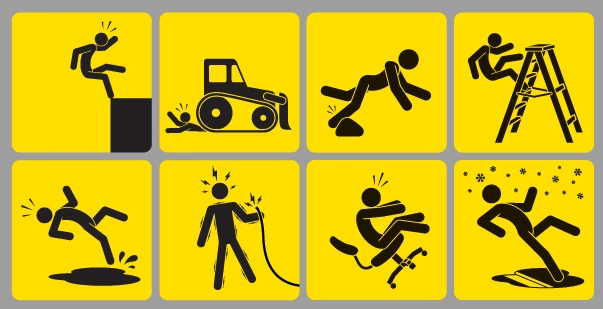Physical hazards are everywhere, but most of us don't notice them until something goes wrong. Have you ever slipped on a wet floor or burned your hand on a hot stove? These are physical hazards in action! They're the silent dangers that can suddenly turn an ordinary day into an emergency.
In 2023, a total of 5,283 workplace fatalities were recorded. Physical hazards include mechanical, electrical, temperature, and radiation risks that can harm our bodies. However, once you recognize these hazards, you can protect yourself and others.
So, what exactly makes something a physical hazard? Keep reading to learn what are the five types of physical hazards and how you can protect yourself from them.
Five Main Types of Physical Hazards
The five main types of physical hazards include mechanical hazards, electrical hazards, thermal hazards, and radiation hazards. Additionally, excessive noise can also be a significant hazard. Each of these has unique risks. Understanding types of physical hazards can help you avoid accidents and injuries.
Read More: What are Biological Hazards - Examples and Preventions
Mechanical Hazards
Mechanical hazards involve dangers from machines or tools that can cause physical harm. This can include cutting, crushing or impact injuries. These types of physical hazards are present in almost every industry which includes construction, manufacturing and even in home environments with tools and household machinery.
Common mechanical hazards include moving parts like gears, belts and blades. If workers are not careful or do not use proper safety equipment, they can get hurt. For example, a moving belt on a conveyor system can trap a hand, or a power saw can cause deep cuts if it isn’t handled properly.
In many cases, these injuries can be serious or even life-threatening. A recent example of a mechanical hazard occurred on January 8, 2025, when Luis Fernando Guerrero Tlatenchi, a 41-year-old mechanic, was fatally crushed by a collapsed forklift at Alco Iron & Metal's San Leandro facility in California. Thus, machines must be well-maintained and fitted with safety guards to prevent mechanical hazards. Moreover, workers should also wear protective gear like gloves, goggles and helmets. In addition, proper training in using machines safely can also reduce the risk of injury.
Electrical Hazards
Electrical hazards are dangers caused by electricity and may result in electric shocks, burns or even fires. These types of physical hazards are particularly dangerous because they can happen quickly and without warning. Electrical hazards are present in almost every workplace, especially in offices, factories and homes.
Electrical hazards can occur when wires are exposed, equipment is faulty, or electricity is misused. For example, touching a live wire can cause severe electric shock, while faulty wiring can lead to fires. Workers involved in electrical work or those who operate machinery are at a higher risk of electrical injuries.
To reduce electrical hazards, it’s important to inspect and maintain electrical equipment regularly. Never handle electrical systems with wet hands, and ensure that all wiring is insulated and in good condition. Electrical workers should wear insulated gloves and use tools designed for electrical work. Following safety guidelines can prevent most electrical hazards.
Thermal Hazards
Thermal hazards relate to extreme heat or cold. Both high and low temperatures can cause injuries or illnesses. Heat can lead to burns, heatstroke, or dehydration, while cold temperatures can cause frostbite or hypothermia. Moreover, these types of physical hazards are found in many industries, such as construction, food service and healthcare.
Workers in hot environments face risks like heat exhaustion or heatstroke, especially if they don’t take enough breaks or drink enough fluids. On the other hand, workers in cold environments may suffer from frostbite, which can damage tissues and even lead to amputation. Thermal hazards also impact outdoor workers who are exposed to extreme weather conditions.
To manage thermal hazards, wear appropriate clothing for the temperature, such as heat-resistant gloves or insulated jackets. In hot environments, take regular breaks, stay hydrated, and stay in cool areas when possible. In cold environments, wear warm layers and avoid long exposure to freezing temperatures.
Radiation Hazards
Radiation hazards occur when the body is exposed to harmful radiation. This can come from various sources, such as X-rays, radioactive materials, or ultraviolet (UV) rays from the sun. Radiation is dangerous because it can penetrate the body and cause internal damage. Healthcare workers, nuclear plant employees, and certain lab workers are most at risk.
There are two main types of radiation hazards: ionizing and non-ionizing radiation.
Ionizing radiation, which includes X-rays and radioactive materials, can cause serious health problems like cancer or organ damage. Non-ionizing radiation, like UV rays from the sun, can lead to skin damage, eye problems, or skin cancer with long-term exposure.
To protect against radiation hazards, it is important to limit exposure time and use protective clothing like lead aprons in hospitals. Workers should follow safety guidelines, wear protective gear and take regular health check-ups to detect any potential damage caused by radiation.
Excessive Noise Hazards
Excessive noise can cause serious health problems, especially when it’s loud and constant. Moreover, it is a common physical hazard in industries such as manufacturing, construction and entertainment. The constant exposure to high levels of sound can damage hearing and lead to conditions like hearing loss or tinnitus (ringing in the ears). The table below summarizes the dangerous level of noise and associated hazards:
To protect against excessive noise hazards, workers should wear hearing protection like earplugs or earmuffs. It’s also essential to reduce noise levels by maintaining equipment using quieter machinery or adding noise barriers. Also, getting certified with relevant construction or HAZWOPER courses helps people be educated about workplace safety, promoting a safer working environment.
Read More: What Is Personal Protective Equipment?
How to Manage Physical Hazards?
Managing physical hazards is required to ensure safety in any environment. Identifying and controlling risks can prevent accidents and injuries. Here are five ways to manage these types of physical hazards effectively, helping workers and individuals stay safe in any setting.
Use Proper Safety Equipment
Always wear the correct protective gear for the task at hand. This includes gloves, helmets, goggles and shoes that are designed to protect against specific hazards. For example, in electrical work, insulated gloves can prevent electrical shocks. In construction, hard hats protect from falling objects. Proper equipment reduces injury risk.
Regularly Maintain Equipment
Machines, tools, and electrical systems should be regularly inspected and maintained. Proper maintenance ensures that equipment is functioning correctly and safely. For example, checking the brakes of a forklift regularly can prevent accidents. Inspecting wiring can prevent faults that may lead to fires or shocks in electrical systems.
Follow Safety Procedures
All workers must follow established safety procedures and Hazard Communication Standards (HCS). This includes proper handling of machinery, following electrical safety protocols, and knowing how to operate equipment safely. Moreover, adhering to these rules helps reduce the risk of accidents and ensures that everyone in the workplace understands the hazards they may face.
Provide Training
Ensure that all workers are properly trained to handle the equipment they use and the hazards they face. Provide OSHA-compliant safety training specific to machinery use, including Lockout/Tagout (LOTO) procedures and PPE usage, which helps reduce injury risks and ensures workers respond correctly during emergencies. Moreover, regular refresher courses help keep workers informed of the latest safety practices.
Create Safe Work Environments
The physical layout of a workspace plays a key role in managing hazards. Keep work areas clean and organized to prevent trips and falls. In areas with high temperatures, cooling systems or air conditioning should be provided to protect workers. Good workplace design can minimize risks and improve safety.
Read More: All About Group Training Programs for Construction Workers
Protect Yourself from Different Types of Physical Hazards!
Physical hazards are common in everyday environments, but with proper management, they can be controlled. Wear the right protective gear, regularly inspect and maintain equipment, and follow established safety protocols. Even small precautions, like proper lighting and clutter-free walkways, can prevent accidents. Most importantly, stay aware of the types of physical hazards and take steps to protect yourself and others. Taking safety seriously and staying informed can ensure that we all remain safe in our work and home environments.
References:





